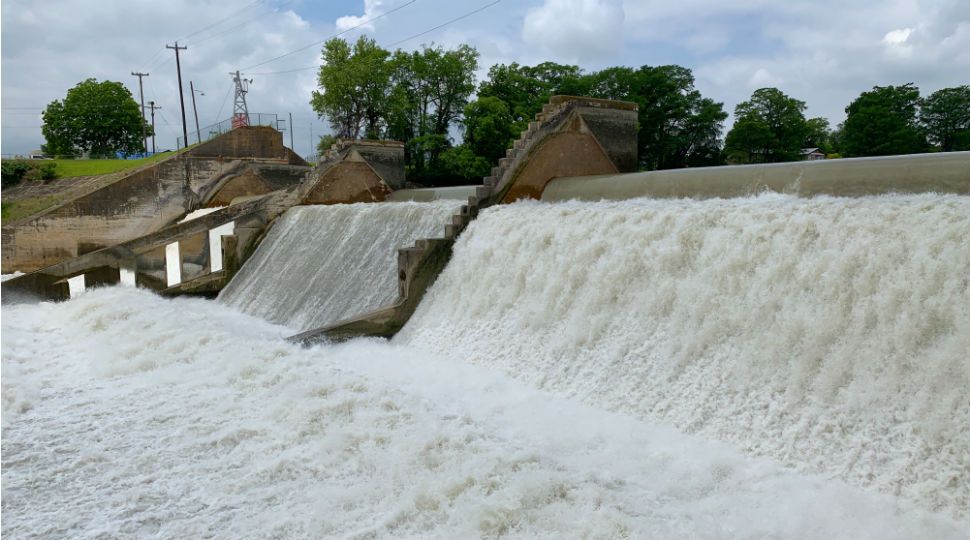NEW BRAUNFELS, Texas -- The Preserve Lake Dunlap Association is helping lakefront property owners take matters into their own hands following the dam failure last month.
- Will be a waterfront-only tax district
- Nearly 500 lakefront owners who want to step up
- GBRA Board of Directors would need to approve any sale of property
The plan is to create a water district, which will be a waterfront-only tax district, supervised by the Texas Commission on Environmental Quality.
PREVIOUS: What's Next for Lake Dunlap? What We Know and What We Don't
The PLDA is leading the charge corralling the nearly 500 lakefront owners who want to step up and fix the dam themselves. The group said this proposal is the only viable solution to the funding issues.
PLDA President J. Harmon said the district would actually own the dam, and the GBRA has offered to transfer to the district for $1.
However, the GBRA Board of Directors would need to approve any sale of property. The agency said forming a water district will enable property owners to have a greater financial and controlling responsibility. The total cost to replace the dam is about $28 million.
PREVIOUS: Guadalupe-Blanco River Authority Reports Spill Gate Failure at Lake Dunlap
If approved, the district would assess an annual tax of about $6 to $8 per linear foot of waterfront property on a 30-year bond. Depending on the size of their lakefront property, homeowners would pay an estimated $1,000 to $2,000 per year.
Homeowner John Moore said it's worth it. He's lived at his home on Lakeside Pass for three years.
"Of course there's pros and cons. It's more money to pay, we've already got some high taxes. But if I had to gauge the people that I've talked to or have had feedback from right now, the majority are in favor," Moore said. "In the big scheme of things, paying less than $1,000, or even $1,000 is worth getting the property values back that a lot of people have lost out on, in my opinion."
Moore is essentially next-door neighbors with the dam at Lake Dunlap. The spill gate failure last month sent him and his family into a frenzy that morning.
"I heard a big boom, the house shook. I ran out the front looking for fire and smoke: nothing. I went out the back looking for fire and smoke and realize, 'Oh, there's water draining really fast out of the dam,'" Moore said.
The potential solution of forming a water district and buying the dam gives Moore hope.
"So we're excited and feel positive about the future and the outlook, but still bummed we're looking at years until we can walk off the dock and be in a tube or swimming or cooling off," Moore said.
GBRA and Guadalupe and Comal Counties would also need to make significant investments to the dam repairs alongside the water district.
PREVIOUS: Lake Dunlap Partially Drained After Spill Gate Failure
"So I think the more heads we get put together, that's going to be great," Moore said. "So keep putting those ideas out there. That feeds that positivity. People are getting on board with 'we do have a potential solution.'"
The next steps are to create subcommittees to focus on filing the application with the Texas Commission on Environmental Quality to become a water district, and if all goes as planned, an election to vote yay or nay on the formation will be held in November.
PREVIOUS: "The Lake is Gone": Residents React to Dam Failure Affecting Lake Dunlap
Spectrum News reached out to GBRA for comment regarding the proposed water district formation and funding. The agency's response is below:
"The creation of a water district by the Preserve Lake Dunlap Association is outside of GBRA’s scope. Specific questions about the creation of a water district should be directed to PLDA.
All options are on the table. GBRA leadership is engaged with the lake associations to discuss and develop options to create a sustainable funding source; however, any action related to sale or transfer of real property or assets of the Guadalupe Valley Hydroelectric System will require approval from the GBRA Board of Directors. As the various stakeholder groups consider ways to participate financially to support the system, questions related to potential ownership have risen. GBRA will work with the individual groups, TCEQ, and legal counsel to identify and address issues related to ownership of the dams and system. Creating a district to fund and maintain the dams will enable property-owners who are directly impacted by the lakes to have a greater financial and controlling responsibility.
Currently, revenue derived from the sale of hydroelectricity produced by the hydroelectric dams is used for their maintenance and repair. From 1963 to 2019, GBRA spent more than $25 million in repairs on all the hydroelectric dams, spillgates, and associated system components. Funding for the replacement of the spillgates at all six dams has not been identified."
MORE COVERAGE:





